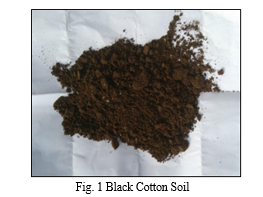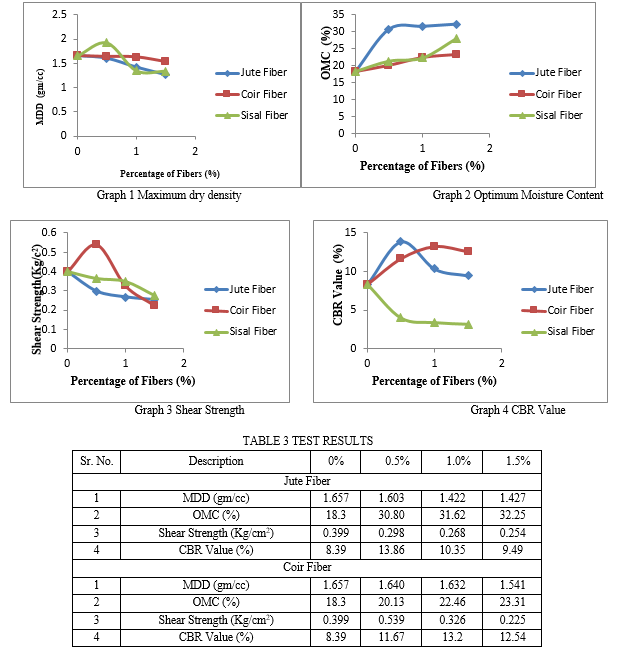Ijraset Journal For Research in Applied Science and Engineering Technology
- Home / Ijraset
- On This Page
- Abstract
- Introduction
- Conclusion
- References
- Copyright
A Comparative Study on Strengthening of Soil with Different Types of Natural Fibers
Authors: Mr. Kate Dinesh Baburao
DOI Link: https://doi.org/10.22214/ijraset.2024.63314
Certificate: View Certificate
Abstract
The soil reinforcement technique is one of the most common techniques used for stabilization of poor soils. The use of natural fibers in Civil Engineering to improve soil properties has the advantages of being inexpensive, locally available, biodegradable and environmentally friendly. The purpose of this study is to determine the behavior of locally available soil with fiber reinforcement. The jute, coconut and sisal fibers were used as additive materials to improve soil strength and comparative properties to determine maximum dry density, California bearing ratio value, standard Proctor test, etc. The various proportions of the jute, coconut and sisal fibers by dry weight of soil were taken as 0, 0.5, 1.0 and 1.5 %. In this study the soil samples were prepared to investigate the effect of natural fibers on the Engineering and strength properties on the all three types of fiber soil samples. The laboratory CBR values of soil and soil reinforced with various fibers were determined. The tests result indicates that CBR value of soil increases with the increase in fiber content. It was observed that increasing the proportions up to 0.5 % there is significant increase in CBR value of soil reinforced with all three fibers and CBR value were goes on reducing after 0.5% proportion. The natural waste fibers can be used to stabilize soil so they can be effectively disposed off.
Introduction
I. INTRODUCTION
The soil properties are varying with a variation in region and construction of structures depends on the bearing capacity of the soil. Therefore we need to stabilize the soil which makes it easier to predict the load bearing capacity of the soil and even improve the load bearing capacity. It is very expensive to replace the inferior soil entirely and hence, soil stabilization is the thing to look for in these cases. Much of central India and parts of southern India, including Madhya Pradesh, Maharashtra, Karnataka, Tamil Nadu, southern Gujarat and Uttar Pradesh, are covered with black cotton soils. Coverage is approximately 3, 00,000 km². These soils are formed from basalt or rock fall. The necessity of stabilization of soil mass is to increase its bearing capacity and to reduce settlements and lateral deformation. The major issue in construction industry is settlement under footing, erosion of embankment and land slide. This is happens because loose soil particles and weak soil structure. The soil can be reinforced with many types of natural fibers such as jute, coir and sisal which are locally and abundantly available in India. The properties of soil get modified with the addition of stabilizers. The experiments have to be done to determine the strength properties of the soil and change in the geotechnical properties of the soil with the addition of natural fibers (jute, sisal, coir). Natural fibers are made by plants, animals and geological processes. They can be used as a part of composite materials where the orientation of the fibers affects their properties. Natural fibers can also be matted into sheets to make products such as paper, felt or cloth. Natural fibers have advantages such as low density, high thermal insulation and low skin irritation. Natural fibers can be classified according to their origin. The vegetable or cellulose-based class includes important fibers such as cotton, flax, jute, animal or protein-based fibers, including wool, mohair, silk and important fibre in the mineral class is asbestos. Jute, sisal and coir fibers are some of the natural fibers that we are using for this study work. The fibers are typically 50–350 mm long and are mainly composed of lignin, tannin, cellulose, pectin and other water-soluble substances. However, due to its high lignin content, coir decomposition takes much more slowly than other natural fibers, resulting in the fiber being extremely durable, with a lifespan in the field it has between 4 to 10 years. Water absorption rate is about 130-180% and diameter is about 0.1-0.6mm. The necessity of stabilization of soil mass is to increase its bearing capacity and to reduce settlements and lateral deformation. In this project, various tests on soil were conducted to find the stabilization of sub base using natural fibre. The various test conducted in order to check the properties of the stabilized black cotton soil are Modified Proctor Test, California Bearing Ratio Test (CBR), and Vane Shear Test. In the present study a series of experimental work was conducted to determine the strength of black cotton soil for various types of natural fibers with different percentage. The index as well as engineering properties have been evaluated. The experiment which performed was Modified Proctor Test, California Bearing Ratio, Vane Shear Test, Plastic Limit and Liquid Limit.
The tests were carried out on black cotton soil with 0, 0.5, 1.0 and 1.5 percent of jute, sisal and coir fibre with water. The results are only applicable for black cotton soil, which is available in Someshwarnagar.
II. MATERIALS AND TESTS
A. Black cotton Soil
Black cotton soil has the major deposits in India. They are not good for a road or construction base. They exhibit a high rate of swelling and shrinkage when exposed to changes in moisture content and have therefore been found to be the most problematic form engineering consideration.

B. Natural Fibers
In this study report the jute, sisal & coir fibers were used as reinforcing materials. Natural fibres are produced from plants, animals and geological processes.
- Jute Fiber: Jute is abundantly grown in Bangladesh, China, India and Thailand. Jute fibers are obtained from the fibrous bark of the jute plant, which grows up to 2.5 m in height and has a trunk diameter of about 25 mm. There are different types of jute fibers with different properties. Jute is primarily an eco-friendly fiber used to make porous fabrics commonly used for filtration, drainage and soil stabilization. Research into the durability and long-term stability of jute fibers will open up areas of use in modern construction. Natural materials such as jute are widely used as floor reinforcement.
- Coir Fiber: Coir fibers are elastic enough to twist without breaking and are permanently curled so they hold their curls. This coconut fiber waste can be used to stabilize the soil so it can be effectively disposed of. The fibers are extracted through a process called debarking. In this process, the leaves are shredded with a rotating hoe equipped with a blunt knife, beaten and brushed off, leaving only the fibers. Proper drying is of utmost importance, as fiber quality is highly dependent on moisture content. Sisal fibers absorb 60-70% moisture and are about 0.06-0.4 mm in diameter.
- Sisal Fibers: Sisal fibers are obtained from the leaves of the plants that are 6–10 cm wide and 50–250 cm in length. In general, Brazil, Indonesia and East African countries are the world’s major producers of sisal fibers. Soil properties are varying widely and the construction of structures depends on the bearing capacity of the soil. Therefore, the ground must be stabilized. This makes bearing capacity of the soil more predictable and can even improve the load bearing capacity. Soil stabilization is appropriate in such cases, as complete replacement of substandard soil is very expensive.

C. Advantages of natural fibers
The main advantages of natural fibers are as follows,
- Fibers are locally available in abundance and are very cheap.
- High moisture absorbing capacity.
- High tensile strength 405.9 N/mm2.
- Create no disposal problem.
D. Properties of Soil & Fibers
The materials used in this study were black cotton soil and fibers (jute, sisal, coir). The soil for experimental investigation was collected from Someshwarnagar, Taluka – Baramati and the sisal, coir and jute were purchased from market.
TABLE 1 PROPERTIES OF BLACK COTTON SOIL
|
Sr. No. |
Properties |
Value |
|
1 |
Liquid Limit |
65.71% |
|
2 |
Plastic Limit |
35.61% |
|
3 |
Specific Gravity |
2.59 |
|
4 |
Maximum Dry Density |
0.168 |
|
5 |
Optimum Moisture Content |
21.09 |
TABLE 2 PROPERTIES OF NATURAL FIBERS
|
Sr. No. |
Properties |
Values |
||
|
Jute |
Sisal |
Coir |
||
|
1 |
Color |
Yellowish Brown |
White |
Brown |
|
2 |
Diameter (mm) |
0.25 |
0.25 |
0.25 |
|
3 |
Average Length (mm) |
10 |
10 |
10 |
|
4 |
Tensile Strength (N/mm2) |
133.5 |
405.9 |
175 |
|
5 |
Density (gm/cc) |
1.46 |
1.45 |
1.13 |
E. Tests on samples
In this study work, various tests on soil were conducted to find the stabilization of sub base using natural fiber. The various test conducted in order to check the properties of the stabilized black cotton soil as follows,
- Modified Proctor Test –IS 2720 (Part VIII):1983
To assess maximum dry density (MDD) and optimum moisture content (OMC), Standard Proctor compaction test is performed as per IS 2720 (Part VII): 1980. A series of standard proctor’s tests will be carried out on the soil sample with varying percentage of fibers.
2.California Bearing Ratio Test - IS 2720(Part XVI):1987
California Bearing Ratio test i s a type of test developed by the California division of highways in 1929. The test will be used for evaluating the suitability of sub grade and the materials used in sub base and base course. A series of California bearing ratio (CBR) tests will be performed on the soil without fibers reinforcement and with different proportion of fibers based on the standard proctor test results.
3. Vane Shear Strength Test - IS 2720(Part XXX):1980
The Shear strength of soil is a measure of its resistance to deformation by continuous displacement of its individual soil particles. This test is performed to find shear strength of a given (generally very soft) soil specimen as per IS: 2720 (Part XXX):1980. Vane shear test is a useful method of measuring the shear strength of soft clay.
III. TEST RESULTS AND DISCUSSIONS
In the present study a series of experimental work was conducted to determine the strength of black cotton soil for various types of natural fibers with different percentage. The index as well as engineering properties have been evaluated. The experiment which performed was Modified Proctor Test, California Bearing Ratio and Vane Shear Test. The result of various tests were discussed and compared in this research paper.
The tests were carried out on black cotton soil with 0, 0.5, 1.0 and 1.5 percent of jute, sisal and coir fiber with water. The various tests were conducted on black cotton soil mixed with different natural fibers coir, sisal and jute in different percentage. The test results obtained from various laboratory investigations are summarized in table.


Conclusion
1) The study focused on the comparison of natural fibers with respect to soil stabilization. From the series of test conducted on black cotton soil mixed with jute, coir and sisal fibers with water, the following conclusions are drawn. 2) The maximum dry density of soil decreased with the addition of jute, coir and sisal fibers. 3) The optimum moisture content increased with the addition of jute, coir and sisal fibers. 4) The CBR values increased with the addition of jute, coir and sisal fiber content. 5) Jute fiber is better than sisal and coir fiber form the bearing capacity point of view 6) The shear strength of soil decreases with increase in the percentage of sisal and jute fiber. 7) The increase in shear strength of black cotton soil was observed for 0.5 percentage coir fiber and decreases with the addition of 1 and above percentages of coir fiber. 8) Coir fiber performs better in the shear strength than other two fibers.
References
[1] Aggarwal P. and Sharma B. \"Application of Jute Fiber in the Improvement of Sub grade Characteristics\", ACEEE International Journal on Transportation and Urban Development, Vol. 01, No. 01, April 2011. [2] Ayininuola G. and Oladotun P., \"Geotechnical Properties of Coconut Coir Fiber Soil Mixture\", Journal of Civil Engineering Research 2016. [3] Bairagi H., Yadav K. and Jain R., \"Effect of Jute Fibers on engineering characteristics of black cotton soil\", International Journal of Engineering Sciences & Research Technology, ISSN: 2277-9655, February 2014. [4] Chaple P. and Dhatrak A., \"Performance of Coir fiber Reinforced Clayey Soil\", International Journal of Engineering and Science (IJES) Volume 2 s., \"Soil Stabilization Using Coconut Coir Fiber\", International Journal for Research in Applied Science & Engineering Technology (URASET), Volume 3 Issue IX, September 2015. [5] Enokela O. and Alada P., \"Strength Analysis of Coconut Fiber Stabilized Earth for Farm Structures\", International Journal of Advancements in Research & Technology, Volume 1, Issue2, July-2012 [6] Hejazi S., Sheikhzadeh M.. Abtahi S. and Zadhoush A., \"A Simple Review of Soil Reinforcement by using Natural and Synthetic Fibers\", Construction and Building Materials-30, 2012. [7] Hossain A., Hossain S. and Hasan K., \"Application of Jute Fiber for the Improvement of Sub Grade Characteristics\", American Journal of Civil Engineering, ISSN: 2330-8729, February 2015. [8] IS 2720 (Part VIII):1983, Indian Standard Methods of Test for Soil, \"Determination of Water Content - Dry Density relation using heavy compaction\". [9] IS 2720 (Part XXX): 1980, Indian Standard Methods of Test for Soils, \"Laboratory Vane Shear Test\". [10] IS 2720 (Part V):1985. Indian Standard Methods of Test for Soil, \"Determination of Liquid and Plastic Limit\". [11] IS 2720 (Part XVI):1987, Indian Standard methods of test for soil, \"Laboratory Determination of CBR\".
Copyright
Copyright © 2024 Mr. Kate Dinesh Baburao. This is an open access article distributed under the Creative Commons Attribution License, which permits unrestricted use, distribution, and reproduction in any medium, provided the original work is properly cited.

Download Paper
Paper Id : IJRASET63314
Publish Date : 2024-06-16
ISSN : 2321-9653
Publisher Name : IJRASET
DOI Link : Click Here
 Submit Paper Online
Submit Paper Online

